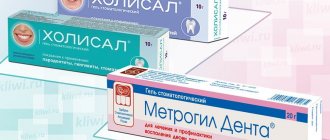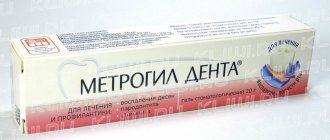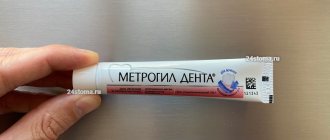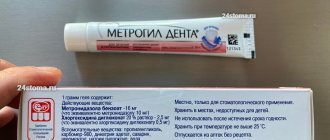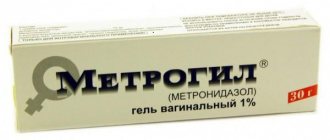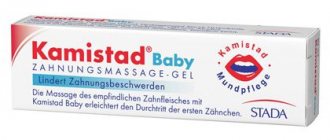Pharmacological properties of the drug Metrogyl vaginal gel
Metrogyl vaginal gel (metronidazole; 1-(β-oxyethyl)-2-methyl-5-nitroimidazole) is an antiprotozoal and antibacterial agent for vaginal use. Highly active against anaerobic bacteria (bacteroides, fusobacteria, clostridia, anaerobic cocci) and protozoa ( Trichomonas vaginalis, Entamoeba histolytica, Lamblia ). Active against most strains of microorganisms that cause bacterial vaginosis: Gardnerella vaginalis, Bacteroides spp., Mobiluncus spp., Peptostreptococcus spp. Aerobic microorganisms are insensitive to metronidazole. The mechanism of action is due to the biochemical reduction of the 5-nitro group of metronidazole by intracellular transport proteins of anaerobic microorganisms and protozoa. The reduced 5-nitro group of metronidazole interacts with the DNA of microbial cells, inhibiting the synthesis of their nucleic acids, which leads to the death of bacteria. After a single vaginal injection of 5 g of vaginal gel, the average maximum concentration of metronidazole in the blood serum of healthy women reaches 237 ng/ml, which is 2% of the average maximum concentration of metronidazole (12.785 ng/ml) when taken orally at a dose of 500 mg. The time to reach maximum concentration is 6–12 hours after a single vaginal injection of 5 g of gel and 1–3 hours after oral administration of metronidazole at a dose of 500 mg. The relative bioavailability of metronidazole in the form of a vaginal gel is 2 times higher than the bioavailability of metronidazole in the form of vaginal tablets (500 mg), which is due to the high penetrating ability of the drug. Therefore, the therapeutic effect of the vaginal gel is achieved at a lower concentration of metronidazole. A lower dose of vaginal gel results in lower serum metronidazole concentrations, which is accompanied by a much lower incidence of side effects.
Features of using Metrogil for acne
Like any other product, the gel must be applied to skin that has been previously cleansed of cosmetics and oil. Wash your face with warm water, dry and apply Metrogyl to the affected area or the entire face, depending on the severity of the rash and its location.
The gel does not contain oils or fats, so it is easily absorbed and does not leave an oily sheen. At the same time, it does not dry out the skin, does not provoke peeling and does not cause a feeling of tightness.
The duration of use of the acne gel is no more than 3-9 months, depending on the severity of the lesion. During this period, complete tissue regeneration will occur and unfavorable microflora will be destroyed.
In case of treatment of demodicosis, the gel is applied to the lesions and a small area of skin around them. For greater therapeutic effect, it is recommended to combine the drug with other anti-inflammatory drugs.
Dermatologists advise combining Metrogyl with any “talkers”, skincare cosmetics that you use every day, as well as other medications that are not analogues of metronidazole.
Many patients misunderstand the term “combine”. Use several means at the same time, i.e. putting one on top of the other is completely wrong. Use Metrogyl in the morning, and in the evening any other product prescribed to you by a cosmetologist or dermatologist. This combination will be the most effective and will speed up the process of treating rashes.
Don't forget about the rules of personal hygiene. Keep linen, towels, makeup brushes and other items that come into contact with your facial skin clean, and do not touch your face with your hands.
Drug interactions Metrogyl vaginal gel
When using Metrogyl vaginal gel topically, the interaction with other drugs is insignificant, however, when administered simultaneously with certain drugs, caution should be exercised: metronidazole enhances the effect of indirect anticoagulants, leading to an increase in prothrombin time; simultaneous use with disulfiram can lead to the development of neurological symptoms, so Metrogyl should not be prescribed to patients who have taken disulfiram over the past 2 weeks; Cimetidine inhibits the metabolism of metronidazole, which may lead to an increase in its concentration in the blood serum and an increased risk of side effects.
Metrogyl for acne: instructions
The list of symptoms for which the drug is indicated is quite extensive:
- rosacea (rosacea);
- chronic inflammatory diseases of the sebaceous glands;
- seborrheic lesions;
- ulcers of the lower extremities;
- long-term non-healing wounds;
- soft tissue necrosis;
- haemorrhoids.
Metrogyl is equally effective against acne and hormonal rashes. It can be used to prevent infection of open wounds, chapping of the face and other serious injuries.
You can only buy acne gel at the pharmacy. The product is available without a prescription, but it is recommended to consult a doctor before use.
Is it worth using Metrogyl gel?
If you survey those who have already used Metrogyl acne gel, the reviews will contain the following advantages:
- pronounced anti-inflammatory effect;
- improvement of the general condition of the skin;
- fewer rashes already in the first month of use;
- rapid healing of wounds and abrasions.
If there are no visible improvements within three weeks, contact your dermatologist; you may need to use additional products to enhance the effect of the gel or choose a different drug.
The result of treatment depends on many factors: the causes of the rash, the severity of the disease, the individual characteristics of the body and compliance with the rules of use.
Metrogyl®
Gastrointestinal disorders: epigastric pain, nausea, vomiting, diarrhea, glossitis, stomatitis, metallic taste in the mouth, decreased appetite, anorexia, dry oral mucosa, constipation, pancreatitis (reversible cases), discoloration tongue / “coated tongue” (due to the growth of fungal microflora).
Immune system disorders: angioedema, anaphylactic shock.
Nervous system disorders: peripheral sensory neuropathy, headache, convulsions, dizziness, encephalopathy and subacute cerebellar syndrome (impaired coordination and synergism of movements, ataxia, dysarthria, gait disturbance, nystagmus, tremor) have been reported, which are reversible after discontinuation of metronidazole , aseptic meningitis.
Mental disorders: psychotic disorders, including confusion, hallucinations; depression, insomnia, irritability, increased excitability.
Visual disturbances: transient visual disturbances, such as diplopia, myopia, blurred contours of objects, decreased visual acuity, impaired color perception; neuropathy/optic neuritis.
Blood and lymphatic system disorders: agranulocytosis, leukopenia, neutropenia, thrombocytopenia.
Disorders of the liver and biliary tract: increased activity of liver enzymes (aspartate aminotransferase, alanine aminotransferase, alkaline phosphatase), development of cholestatic or mixed hepatitis and hepatocellular liver damage, sometimes accompanied by jaundice; In patients treated with metronidazole in combination with other antibacterial agents, cases of liver failure requiring liver transplantation have been observed.
Skin and subcutaneous tissue disorders: rash, itching, skin flushing, urticaria, pustular skin rash, Stevens-Johnson syndrome, toxic epidermal necrolysis.
Renal and urinary tract disorders: brownish-reddish coloration of urine due to the presence of a water-soluble metabolite of metronidazole in the urine, dysuria, polyuria, cystitis, urinary incontinence, candidiasis.
General disorders and disorders at the injection site: fever, nasal congestion, arthralgia, weakness, thrombophlebitis (pain, hyperemia or swelling at the injection site).
Laboratory and instrumental data: flattening of the T wave on the electrocardiogram.
Metrogyl gel for external use 30g
Compound
Active substance: metronidazole 10 mg.
Excipients: methyl parahydroxybenzoate, propyl parahydroxybenzoate, carbomer 940, disodium edetate, sodium hydroxide, propylene glycol, purified water.
Pharmacokinetics
Absorption is minimal; after external use of the gel, only trace amounts of the drug are found in the blood serum. Absorbed metronidazole passes through the placenta and blood-brain barrier. Cmax in the blood - up to 66 ng/ml (when applying 1 g of gel, equivalent to 7.5 mg of metronidazole).
Indications for use
- Rosacea (including post-steroid acne);
- acne vulgaris;
- oily seborrhea, seborrheic dermatitis;
- trophic ulcers of the lower extremities (against the background of varicose veins, diabetes mellitus);
- poorly healing wounds;
- bedsores;
- hemorrhoids, anal fissures.
Contraindications
Hypersensitivity to the components of the drug.
Directions for use and doses
For external use. The gel is applied to previously cleansed affected areas of the skin in a thin layer 2 times a day, morning and evening, for 3-9 weeks.
The duration of treatment is 3-4 months, the therapeutic effect is usually observed after 3 weeks of treatment.
Storage conditions
Store at a temperature not exceeding 30°C, out of the reach of children. Do not freeze.
Best before date
3 years. Do not use after the expiration date stated on the packaging.
special instructions
Avoid contact with eyes. If the gel gets into your eyes, rinse them immediately with plenty of water.
Description
Antiprotozoal drug with antibacterial activity for external use.
Pharmacodynamics
Metronidazole is a synthetic broad-spectrum antimicrobial and antiprotozoal agent from the group of imidazoles. Active against anaerobes (Bacteroides spp., Fusobacterium spp., Mobiluncus spp., Peptococcus spp., Peptostreptococcus spp., Clostridium spp., Eubacterium spp., Bacteroides fragilis, Prevotella spp.) and protozoa (Trichomonas vaginalis, Giardia intestinalis, Entamoeba histolytica).
When applied topically, it has an anti-acne effect, the mechanism of which is precisely unknown (not related to the effect on the Demodex folliculorum mite, found in hair follicles and the secretion of the sebaceous glands, and any effect on the production of this secretion).
Metronidazole for external use may have antioxidant activity. It has been found that it significantly reduces the production of active oxygen, hydroxyl radicals and hydrogen peroxide by neutrophils, which are potential oxidants that can cause tissue damage at the site of inflammation. Metronidazole for external use is not effective against telangiectasias noted with rosacea.
Side effects
When the gel is applied topically, the concentration of metronidazole in the blood is very low, so the risk of systemic side effects is low.
Rarely, allergic reactions (urticaria, skin rash) may occur; hyperemia, peeling, slight dryness and burning of the skin, lacrimation (if the gel is applied close to the eyes).
Use during pregnancy and breastfeeding
With caution - first trimester of pregnancy, lactation period.
Interaction
When the gel is applied topically, interaction with other drugs is negligible, but caution should be exercised when administered simultaneously with warfarin and other indirect anticoagulants (increases prothrombin time).
Overdose
There were no cases of drug overdose in recommended doses when using the drug externally.
Impact on the ability to drive vehicles and operate machinery
The drug does not affect the ability to drive a car or operate moving mechanical equipment.
Special instructions for the use of the drug Metrogyl gel
Avoid getting the gel in your eyes. When applied to large areas of skin or with prolonged use, there is a possibility of resorption of metronidazole and the development of systemic side effects, so the drug should be prescribed with caution to patients with impaired hematopoietic function. If local reactions occur, the drug should be used less frequently or temporarily discontinued. Metronidazole penetrates well into breast milk, so it is not recommended to use Metrogyl during breastfeeding. After applying the gel, you can use cosmetics. During pregnancy, it is prescribed only if absolutely necessary.
